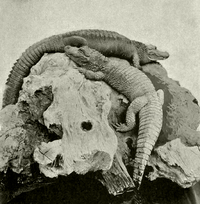
Photo from wikipedia
The size ranges of ore pillars play important roles in preventing the occurrences of rock burst phenomena. Due to the lack of research on the relationship between crack evolution behaviors… Click to show full abstract
The size ranges of ore pillars play important roles in preventing the occurrences of rock burst phenomena. Due to the lack of research on the relationship between crack evolution behaviors and bursting liability of rocks with different sizes, uniaxial compression tests on sandstone with different height-to-diameter ratios (H/D) were conducted. The results showed that the mechanical parameters of sandstone have obvious size effects, in which both the peak strength and peak strain decrease with increases in the H/D. Moreover, the brittle index modified value (BIM) decreased, but the impact energy index increased gradually, which indicated the increase of bursting liability. With the increases in the BIM, the overall crack strain parameters increased, thereby indicating a positive correlation. With the increase in the impact energy index, the crack strain decreased and the bursting liability became higher. Although the axial crack closure stress and axial crack damage stress increased with the increases in BIM (indicating a positive correlation), the bursting liability became increasingly smaller. The crack stress decreased with the increases in the impact energy index, and the bursting liability became stronger. The findings of this study will potentially provide experimental references for furthering the current understanding of the mechanism of rock bursts in underground coal mines in China.
Journal Title: ACS Omega
Year Published: 2023
Link to full text (if available)
Share on Social Media: Sign Up to like & get
recommendations!